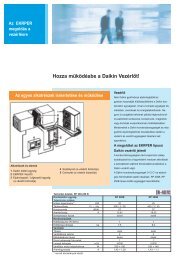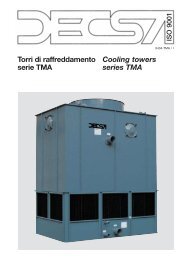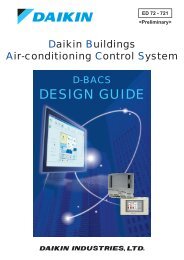technical data
technical data
technical data
You also want an ePaper? Increase the reach of your titles
YUMPU automatically turns print PDFs into web optimized ePapers that Google loves.
����������������������������������<br />
��������������������������������������<br />
1.Technical background<br />
When installing VRV outdoor units collectively on the rooftop, the suction temperature increases due to the heat emanated from other outdoor units (air short circuit).<br />
As a result, in cooling system, the COP is lowered because of decreased equipment capacity and increased power consumption. In some cases, outdoor units stop<br />
operations due to abnormally high pressure. When installing these units, choose the most suitable layout for on-site space conditions from the installation options below,<br />
while taking walkway space and ventilation into consideration.<br />
* For other installation patterns, determine the appropriate installation method based on the space conditions, referring to the installation examples below.<br />
For the space in front of the units, please ensure there is enough space for refrigerant piping work. The required installation space shown in the illustrations is based on the<br />
cooling operation at 35°C of outside temperature. When the design outside temperature exceeds 35°C, make the inlet space larger than spaces shown in the illustrations.<br />
2. Installation examples (up to 24 units)<br />
Here shows basic collective installation examples of 16 HP units when 1600mm-high walls surround outdoor units, which is as high as outdoor units. Please be sure that<br />
the distances from each wall and between outdoor units are larger than the figures shown in illustration diagrams.<br />
���������������������������<br />
Determination of the Installation Location<br />
SELECTION OF LOCATION<br />
This unit, both indoor and outdoor, is suitable for installation in a commercial and light industrial environment.<br />
If installed as a household appliance it could cause electromagnetic interference.<br />
The VRV outdoor units should be installed in a location that meets the following requirements:<br />
1. The foundation is strong enough to support the weight of the unit and the floor is flat to prevent vibration and noise generation.<br />
2. The space around the unit is adequate for servicing and the minimum space for air inlet and air outlet is available.<br />
(Refer to below figure and choose one of both possibilities.)<br />
3. There is no danger of fire due to leakage of inflammable gas.<br />
4. Ensure that water cannot cause any damage to the location in case it drips out the unit (e.g. in case of a blocked drain pipe).<br />
5. The piping length between the outdoor unit and the indoor unit may not exceed the allowable piping length. (See “Example of connection”.)<br />
6. Select the location of the unit in such a way that neither the discharged air nor the sound generated by the unit disturb anyone.<br />
7. Make sure that the air inlet and outlet of the unit are not positioned towards the main wind direction.<br />
Frontal wind will disturb the operation of the unit. If necessary, use a windscreen to block the wind.<br />
����������<br />
�������������������������<br />
��������<br />
���<br />
�������<br />
���<br />
���� ���<br />
���<br />
������<br />
���������<br />
�������<br />
�������<br />
�������<br />
�������<br />
��<br />
��<br />
�����������������������������������<br />
���<br />
��� ���<br />
��<br />
�������<br />
�������<br />
�������������������<br />
����������������������������������� ����������������������������<br />
9 Outdoor Unit Layout Guide<br />
���<br />
���<br />
��� ����<br />
��<br />
�������<br />
�������<br />
��<br />
���� ����<br />
����<br />
�������<br />
�������<br />
Fresh air<br />
Fresh air







